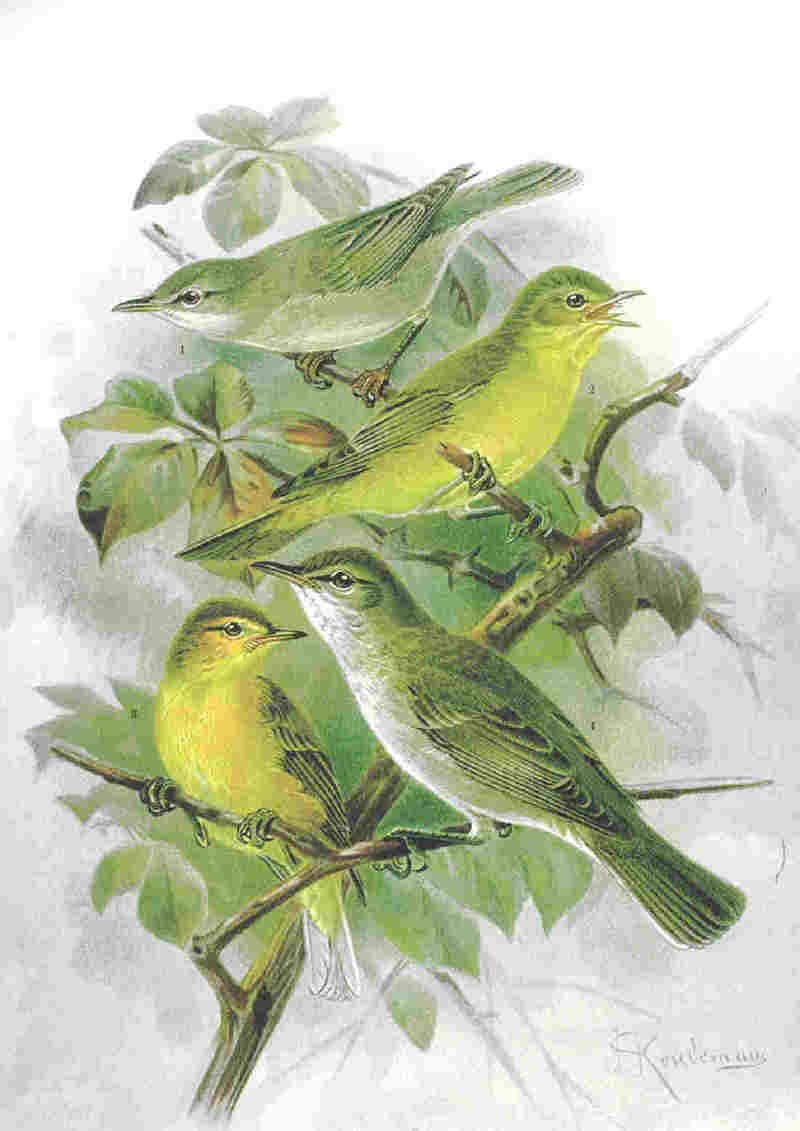|
| 질의: marsh warbler | 결과: 15번째/23 | |
Tree Warbler (Family: Acrocephalidae, Genus: Hippolais) - Wiki
| 제목: | Tree Warbler (Family: Acrocephalidae, Genus: Hippolais) - Wiki
| |

| 해상도: 1102x1558
파일크기: 81149 Bytes
등록시간: 2007:12:10 11:39:48
|
ERROR : Server Busy(-1105)
ERROR : Server Busy(-1105)
Tree Warbler (Family: Acrocephalidae, Genus: Hippolais) - Wiki
Tree warbler
From Wikipedia, the free encyclopedia
Order: Passeriformes
Family: Acrocephalidae
Genus: Hippolais
[Photo] Several species of Hypolais or Hippolais birds. 1. Hypolais pallida 2. Hypolais philomela * 3. Hypolais polyglotta 4. Hypolais olivetorum. From: NAUMANN, NATURGESCHICHTE DER V??GEL MITTELEUROPAS: Band II, Tafel 4 - Gera, 1897. Source: www.biologie.uni-hamburg.de/b-online/birds/2181_32.htm
Tree warblers are medium-sized birds belonging to the genus Hippolais, formerly placed in the "Old World warbler" family Sylviidae but now separated in the marsh- and tree-warbler family Acrocephalidae. They occur in Europe, Africa and western Asia.
These warblers are always associated with trees, though normally in fairly open woodland rather than tight plantations. They are quite clumsy in their movements.
These are plump, strong-looking birds with long bills, strong feet and long wing. Most are unstreaked greenish or brownish above and cream or white below. They are insectivorous, but will occasionally take berries or seeds.
Species breeding in temperate regions are usually strongly migratory.
Considerable evidence, much of it summarised in Parkin et al (2004), suggests that the genus Hippolais is paraphyletic with respect to Acrocephalus. DNA studies e.g. Leisler et al (1997), interpreted in Sangster (1997), indicated that the olivaceous and Booted/Sykes's warbler grouping (the subgenus Iduna) are more closely related to Acrocephalus species than they are to Icterine and Melodious Warblers and as a result the Dutch CSNA has moved these four species into Acrocephalus. A subsequent review by the BOURC retained the genus Hippolais, for all eight species, but in agreement with Sangster, acknowledged that they fell into two groups. The retention of the Iduna grouping within Hippolais was done because it was felt that more evidence was needed for its placement, because of low bootstrap values, rather than because of a belief that the status quo was correct - no evidence was put forward to refute the DNA findings. Mark Constantine, in "The Sound Approach to Birding" illustrated that there is extensive overlap in song types between species from the two genera, and that vocally, no characters existed which enabled species to be sorted into one genus or the other. Kenneth Wiliamson and Hadoram Shirihai, in discussing the identification of Hippolais and Acrocephalus warblers stressed the similarities between species in the two genera. Colin Bradshaw, in British Birds, has written several articles on morphological similarity between cross-generic species-pairs e.g. Eastern Olivaceous and Blyth's Reed warblers (Bradshaw 2000) and Paddyfield and Booted warblers (e.g. Bradshaw & Steele 1995, Bradshaw & Steele 1997, the latter a response to Lars Svensson's comments on Bradshaw & Steele 1995).
The species are:
(subgenus Iduna)
Booted Warbler, Hippolais caligata
Sykes' Warbler, Hippolais rama
Western Olivaceous Warbler, Hippolais pallida
Eastern Olivaceous Warbler, Hippolais opaca
(subgenus Hippolais)
Upcher's Warbler, Hippolais languida
Olive-tree Warbler, Hippolais olivetorum
Melodious Warbler, Hippolais polyglotta
Icterine Warbler, Hippolais icterina
http://en.wikipedia.org/wiki/Tree_warbler
| The text in this page is based on the copyrighted Wikipedia article shown in above URL. It is used under the GNU Free Documentation License. You may redistribute it, verbatim or modified, providing that you comply with the terms of the GFDL. |
|
^o^
동물그림창고 똑똑전화 누리집
^o^
|
|